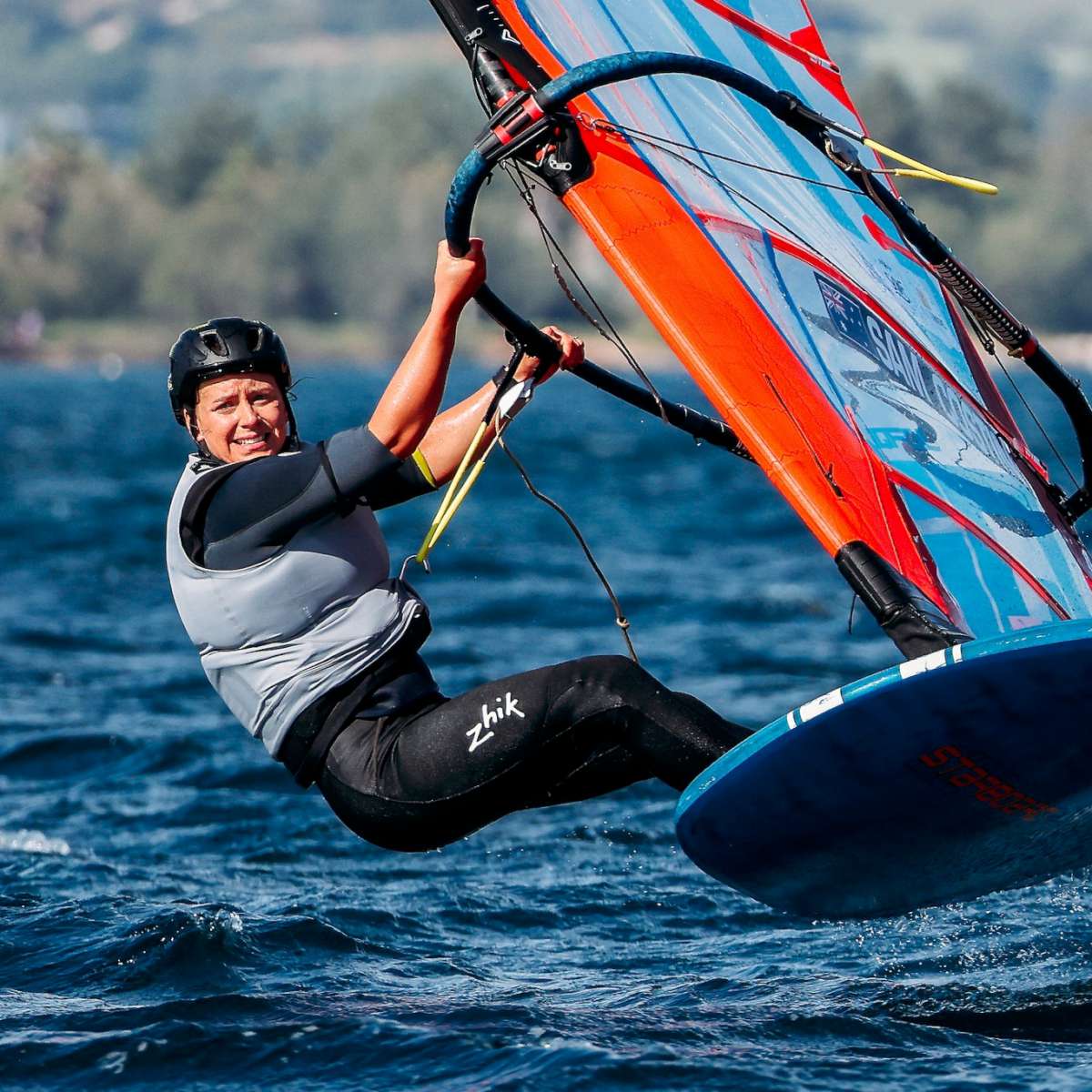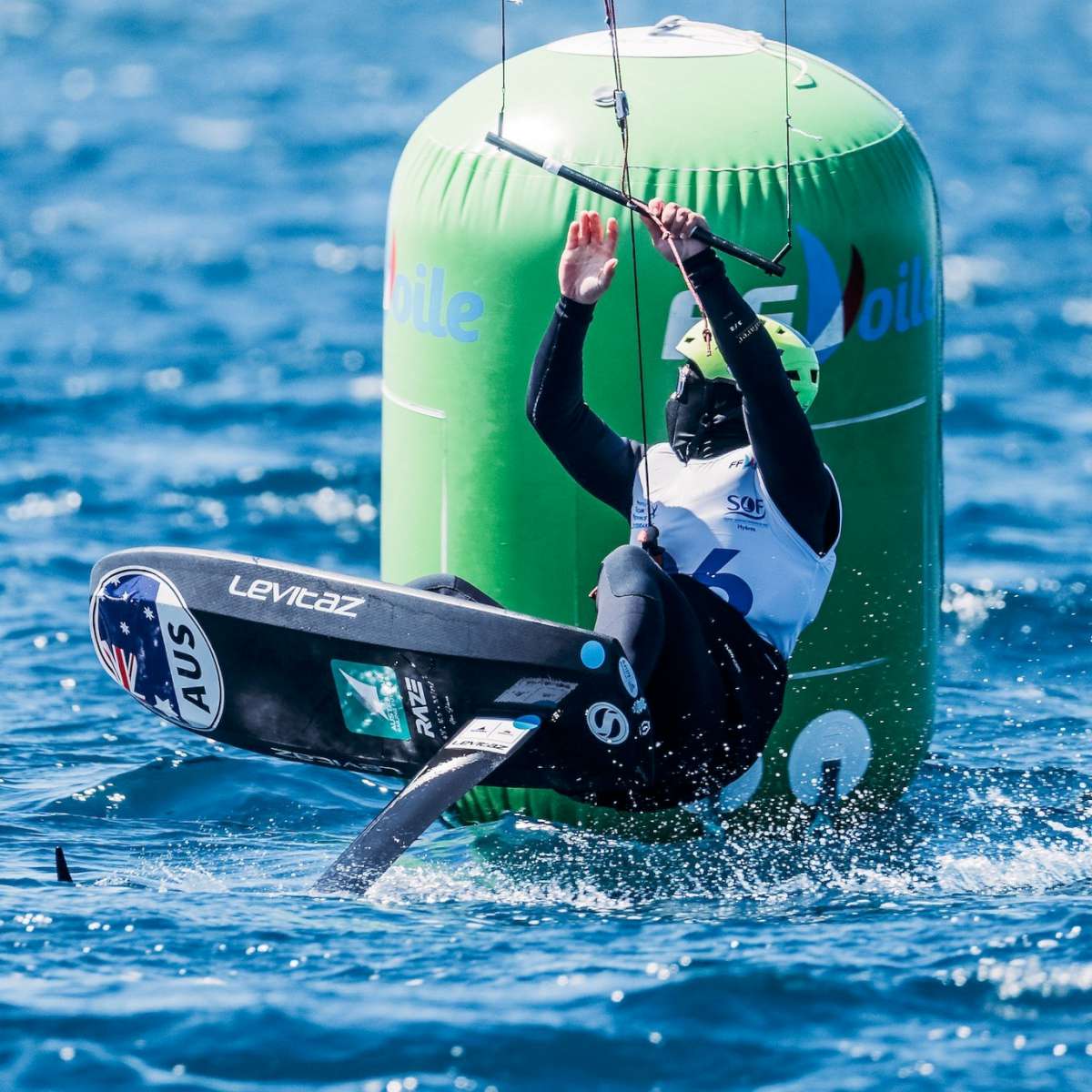On Friday (28 June), gusts of force six to seven (24-30 knots) caused problems for the Kiel Week athletes on all five regatta courses in eight international boat classes. The planned racing programme was shortened in the early afternoon “because the wind had picked up so much that we put safety first,” said chief race officer Fabian Bach. The 33 safety boats, 20 regular and 13 additionally activated, as well as numerous others were quickly running at 100 per cent capacity. Torn sails, broken masts and 16 injuries were the overall result of a tough day at sea, which offered spectacular images in plenty of sunshine. “All the active participants and the strong team of helpers are safely back on shore,” summed up regatta organisation manager Dirk Ramhorst in the late afternoon, “it was exemplary teamwork.”
Professor Alexander Heckel, Head of Division and Operations in Schilksee, agreed: “This was thanks to the incredibly good communication between the security forces Wasserwacht and DLRG as well as the THW and DGzRS on the one hand and the organisers from the Kiel Yacht Club on the other.” Two seriously injured people were hospitalised, and most of those affected shrugged off their injuries. Everyone involved was particularly relieved when a 2.4mR sailor from Sweden who had initially gone missing checked in back on shore after his boat was found outside without him and without a sail, i.e. without a sail number.
The second day of the regatta in the second part of Kiel Week demanded plenty of skill from the sailors. By early afternoon, however, the protagonists’ reserves were exhausted. While gusts of up to 30 knots whipped across the regatta courses of the outer fjord, the water began to foam. Up to four races were planned. However, the wind picked up so strongly that numerous participants cancelled their sails prematurely of their own accord and the day was finally finished after a maximum of three races in eight classes.
The reasons for the cancellation were complex: while the ILCA 4 youngsters were at the end of their tether, the 2.4mRs were struggling with the waves that were crashing into their cockpits, flooding the boats and making sailing impossible. On the outer courses, close to the Kiel lighthouse, the conditions also overtaxed some of the equipment. The day began in ideal conditions with medium winds from the west. However, the races ended in a totally different scenario.
The ILCA-4-Youngster and the 2.4mR had an extreme race on course India. Blood runs from his cheekbone down his right cheek, his sun and salt water-streaked eyes hidden behind mirrored sunglasses, as world champion Heiko Kröger landed his 2.4mR boat safely on the jetty. “I sailed on through the last race because I hadn’t even realised that it had already been abandoned,” reports the 14-time Kieler Woche winner, who is once again on course for his 15th title after the second, but ultimately extreme, day of racing. The small keelboats were particularly hard hit by waves up to one and a half metres high. The champion also “almost ran aground when I couldn’t get the sheet out of the jam and lost rudder control, it was close to the limit.” After five races, the 58-year-old is three points ahead of Marko Dahlberg from Finland. The two-time world champion snatched two of the day’s victories from him. And then what happened? Kröger: “An ILCA hit me in the harbour, suddenly I had the bow in my face.”
Manfred Kieckbusch arrived in the Olympic harbour alongside a DLRG inflatable boat. His 2.4mR “swam” around 20 centimetres below the surface of the water. “It was one wave too many, then the boat is full and you have no chance of pumping it empty,” says the man from the Arnisser Segel-Club, “that happened to me for the first time.” At Kieler Woche and at the end of July at the World Championships in the same place, “only the good ones can cope with it”. His seat, various lines and small items were lost, the tow into the harbour was “like an interval dive”, but in the meantime the skipper was completely soaked and “on dry shore” again, he is 26th.
The record world champions in the Flying Dutchman, Hungary’s Szabolcs Majthenyi/Andras Domokos, also admitted: “Yes, it was too much”. The Hungarians had to settle for fourth place in the final race of the day, but remain at the top of the rankings ahead of the reigning world champions Kay-Uwe Lüdtke/Kai Schäfers after four victories to date. The Hungarians have been the absolute world leaders since 1994 and obviously remain so. Domokos: “We have a good boat set-up and come here very well prepared.”
In the Contender, the top of the field is moving closer together – with a new leader. World champion Sören Andreasen (Denmark) has overtaken his compatriot, European champion Jesper Armbrust. Both are level on points and are just one point ahead of Christoph Homeier from Bremen. Max Billerbeck, the 2019 world champion, lost some ground after finishing eighth in the final race of the day in fourth place overall. “The last race was really tough.” On downwinds, Billerbeck reported that the rig was pushed so far forwards that the forestay tensioner was resting on the deck.
The day turned into an elimination race for the OK dinghies. The field of 71 starters was gradually reduced. 19 athletes made it to the finish in the third race. Many had given up beforehand out of consideration for themselves and their equipment. Others complained about torn sails, ripped out fittings and broken decks. Bo Petersen also skipped the last race, but was able to drop the score. As a result, he remains the leader on equal points ahead of the Swede Niklas Edler and Jan Kurfeld (Wismar).
The Finnish ILCA-6 sailor Monika Mikkola presented herself as a prime example of endurance. After the five days of Kiel Week in the Olympic part, she is now also continuing in the international part. Even against male competition, the 28-year-old did not let up and achieved further top results. However, she had to admit on her seventh consecutive day of sailing: “I’m very exhausted. It was tough against the boys today. It’s a big physical challenge.” …which she seemed to master better and better as the strain increased. After finishing fourth and second, she was on course for victory in the third race of her group.
However, she made a manoeuvre mistake shortly before the last mark. Preparing for the gybe, she slipped in the boat, suddenly got pressure in the sail and could no longer hold the bopat when the boom hit the water. As a result, she capsized and lost her top position. She now ranks third overall. The Frenchman Alexandre Kowalski, who took three wins in the parallel group, is in the lead, as is the Ukrainian Sofiia Naumenko in second place overall.
Despite a scratch result on the day, Switzerland’s Jean Glauser defended his lead in the ILCA 4 ahead of Ivan Gribov (Ukraine) and Tristan Schnitzer (also Switzerland). In contrast, the top positions in the keelboat classes were freshly shuffled, with two races finishing. In the J/24 it remains a Hamburg double lead, albeit with a completely new line-up. Fritz Meyer and his crew lead ahead of Stefan Karsunke and Dirk Olyslagers from the Netherlands. Julian Ramm (Itzehoe) took the lead in the J/70. Kim Christensen (Denmark) and Kai-Uwe Hollweg (Bremen) have settled into the chasing positions.
Click HERE for results.
@kielerwochesailing




























